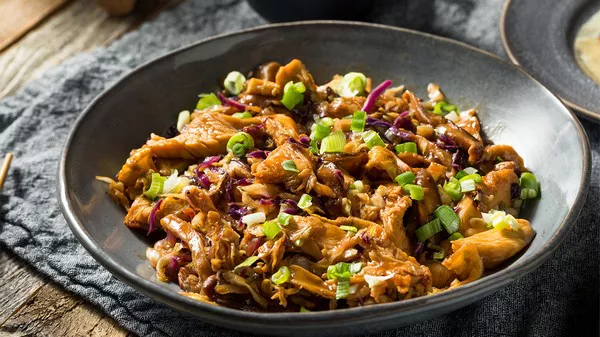Chinese cuisine is renowned for its diverse flavors, vibrant colors, and exquisite culinary techniques. While some Chinese dishes may be perceived as unhealthy due to high sodium, oil, or sugar content, there are numerous options within Chinese cuisine that can be part of a balanced and nutritious diet. In this article, we explore the healthiest Chinese food choices, highlighting dishes that incorporate fresh ingredients, lean proteins, and an emphasis on balance and harmony.
Here Are 12 Healthiest Chinese Food Options:
1. Steamed dumplings
Dumplings offered at a Chinese restaurant are pockets of dough filled with seasoned meat and vegetables, usually pork and cabbage.
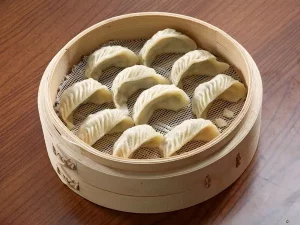
They are often fried, but you can choose to have them steamed instead to cut down on calories and fat. One medium steamed dumpling is only 40 calories.
Although the soy-sauce-based dipping sauce is low in calories, it’s high in sodium, so try to limit how much sauce you use especially if you’re salt sensitive.
2. Hot and sour soup or egg drop soup
Egg drop soup is made simply with ribbons of cooked egg in chicken broth.

Hot and sour soup is made with mushrooms, bamboo shoots, eggs, and ginger in chicken broth. It also contains vinegar and spices, which add the hot and sour components to the dish.
Both soups are low in calories — containing only 65–90 calories per 1-cup (240 mL) serving — and you can make them even healthier by avoiding the fried lo mein noodles that are often offered as a topping.
3. Moo goo gai pan
Moo goo gai pan is a lightly sauced chicken and vegetable stir-fry dish that contains mushrooms, broccoli, carrots, and water chestnuts.
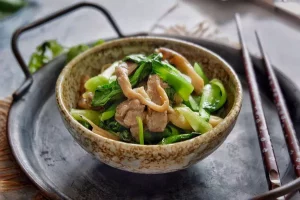
Because it’s full of vegetables and lean chicken, it’s relatively low in calories. Furthermore, the chicken provides plenty of protein, making it a filling dish. One cup (216 grams) contains only 160 calories while offering 15 grams of protein.
4. Beef and broccoli
Beef and broccoli is a simple dish of stir-fried beef and broccoli tossed in a light sauce.
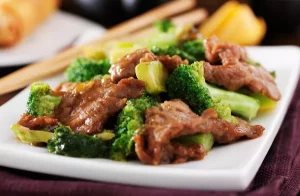
It’s a relatively healthy dish that’s low in carbs and high in protein. However, it’s often made with fatty cuts of beef. One cup (217 grams) contains 336 calories, 23 grams of fat, and 23 grams of protein.
5. Chop suey
Chop suey is another stir-fry dish made from meat, eggs, and thinly sliced vegetables in a light sauce. It’s often made with pork, although some varieties may contain chicken, beef, or tofu.
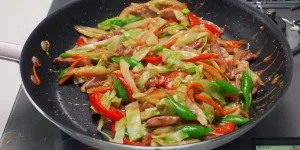
Like other stir-fries, it’s a healthier choice because it’s made from a protein source and vegetables. One cup (220 grams) of pork chop suey with no noodles contains 216 calories and provides 23 grams of protein. It also contains about 9.5 grams of fat, and a restaurant version may have more fat added during the stir-fry process.
6. Chicken and broccoli
Chicken and broccoli is similar to beef and broccoli, consisting of chicken and broccoli stir-fried in a light sauce.
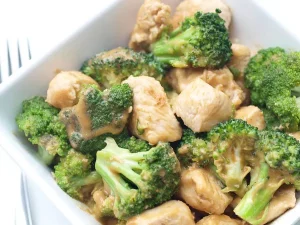
However, it’s a leaner option than beef and broccoli that still offers plenty of protein. One cup (153 grams) provides 13 grams of protein and only 145 calories. It also contains about 7 grams of fat.
If possible, ask to have the dish steamed. You will lose the oil that it’s normally cooked in, which will lower its fat and calorie content to give it a healthier twist.
7. Baked salmon
Many Chinese restaurants offer a baked salmon option, which is a great choice.
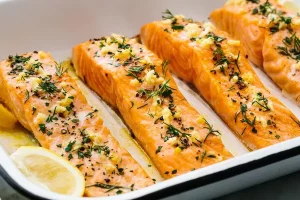
Baked salmon is high in protein, rich in healthy omega-3 fats, and free of carbs. A 3-ounce (85-gram) portion cooked with butter contains 156 calories, 21 grams of protein, and 7 grams of fat.
Paired with a side of steamed vegetables, baked salmon is a perfect entrée for low carb or keto dieters.
8. Buddha’s delight
Buddha’s delight is a great option for vegans and vegetarians. It’s a stir-fry made with tofu and steamed vegetables like bok choy, cabbage, and broccoli in a light, savory sauce.
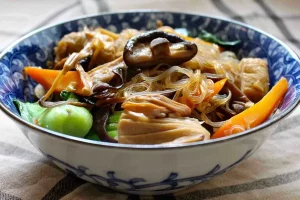
Because it’s completely plant-based, it contains some fiber, as well as protein from the tofu. One cup (217 grams) provides 193 calories and contains 3 grams of fiber and 9 grams of protein.
Additionally, tofu is one of the few complete proteins available to vegans and vegetarians, meaning it contains all nine of the essential amino acids your body needs to build new proteins.
9. Moo shu vegetables
Vegetables take center stage in this popular takeout dish, which typically features ingredients like stir-fried pork, shredded cabbage, mushrooms, carrots, and onions.
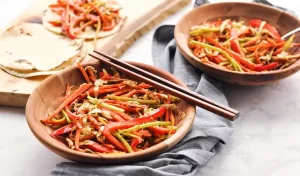
Although the exact nutrient content can vary based on which ingredients are used, one cup (151 grams) typically contains approximately 230 calories and nearly 16 grams of protein. Also, it contains about 16 grams of fat, but like most stir-fry dishes, fat content can vary depending on the restaurant.
To maximize the potential heatlh benefits, go light on the sauce and consider skipping the side of pancakes that it’s usually served with.
10. Eggplant with garlic sauce
Eggplant with garlic sauce is a dish comprised of smoky, grilled eggplant topped with a rich and tangy garlic sauce.
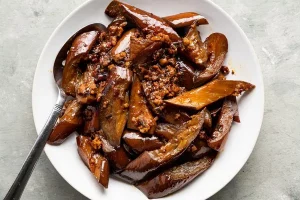
Eggplant, the star ingredient of the dish, is low in calories and a great source of several key nutrients, including fiber, manganese, folate, and potassium.
It also features several other nutrient-dense ingredients, such as garlic, ginger, and peppers.
Opt for a side of brown rice rather than white rice to bump up the fiber content of your meal and squeeze in an extra serving of whole grains.
11. Kung pao chicken
Kung pao chicken is a spicy Sichuan dish that contains stir-fried chicken with peanuts, chili peppers, and vegetables.
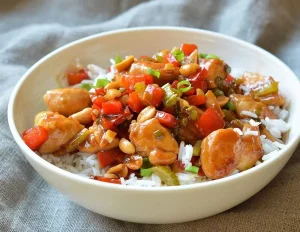
Not only is it high in protein and micronutrients like niacin and selenium, but it’s also topped with peanuts, which are a great source of heart-healthy monounsaturated fats.
Try asking the restaurant to throw in some extra veggies and consider limiting your portion size if you’re keeping an eye on your sodium intake, as it sometimes contains high amounts of salt.
12. Shrimp with lobster sauce
Despite its name, shrimp with lobster sauce does not actually contain lobster. Instead, it’s made using a fermented black bean sauce often used to prepare lobster in traditional Cantonese cuisine.
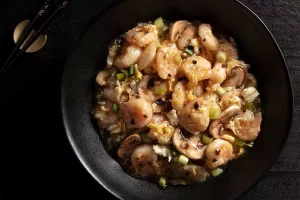
In addition to stir-fried shrimp, the dish typically contains veggies like peas, carrots, garlic, and scallions.
Compared to many other takeout options, it’s relatively low in calories and high in protein, with 31 grams of protein and 279 calories in a 1-cup (185-gram) serving. It also contains 14.5 grams of fat.
You can also boost the available fiber, vitamins, and minerals by requesting extra vegetables such as broccoli, mushrooms, or bell peppers.
Conclusion
Chinese cuisine offers a wealth of delicious and nutritious options that can be part of a healthy lifestyle. By choosing wisely and being mindful of cooking methods and ingredients, it is possible to enjoy the healthiest Chinese food while embracing the rich flavors and cultural heritage. Incorporating these dishes into your dining repertoire can provide a delightful culinary experience that nourishes both the body and the soul.

